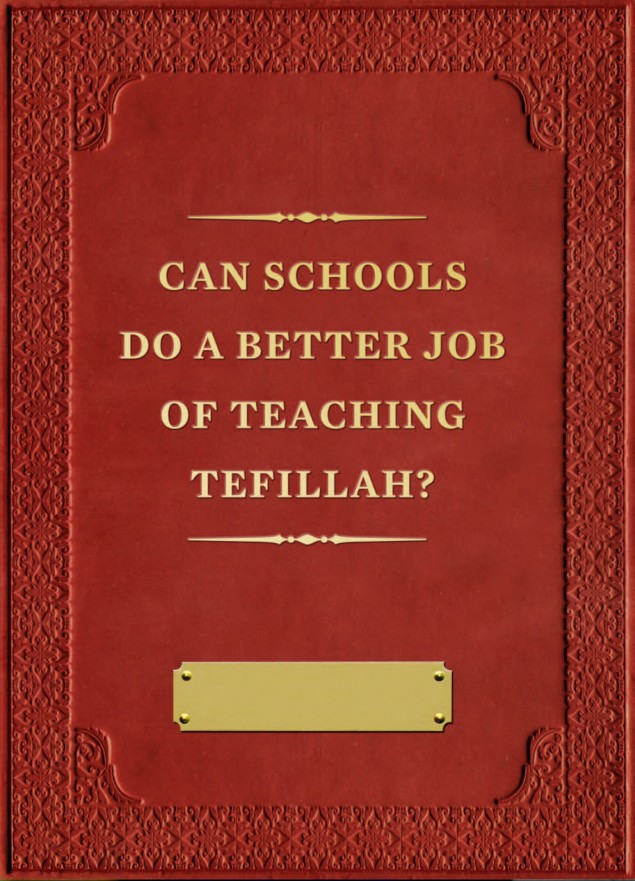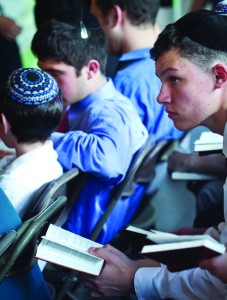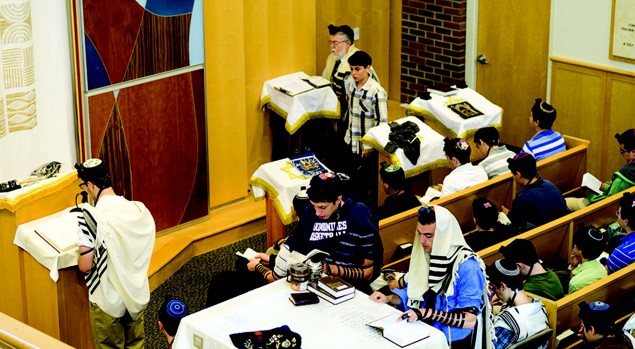Can Schools Do a Better Job of Teaching Tefillah?
Rafi Diamond’s day school course on Jewish prayer came at a fortuitous time a few years ago. Rafi was a student at Maimonides School, a K-12 Modern Orthodox institution in Boston. He was studying the “R’faeinu” (“Heal us”) prayer for health in the Shemoneh Esrei which includes the words “bring complete recovery for all our ailments . . . [Hashem] heals the sick of His people Israel.” Rafi had given no special thought to the relevance of the prayer, he says. Then a relative became very sick; R’faeinu became relevant.
Rafi’s lessons about the meaning of the R’faeinu prayer gave his davening greater kavanah, more intensity and devotion, he says. His relative recovered, and Rafi, who graduated this past June from Maimonides, says its tefillah curriculum strengthened his prayer life—which is the purpose of the high school-level prayer curriculum.
Patterned after the teachings of the late venerated Rabbi Dr. Isaiah Wohlgemuth, the Maimonides School tefillah curriculum offers both the historical context and philosophical underpinnings of individual prayers. Additionally, it emphasizes the interpretation of the words and the structure of the siddur. The curriculum, say many people familiar with the Jewish educational field, is considered the gold standard of day schools in North America—one that offers depth and breadth, that engages adolescent students’ interest, that inspires them to keep praying and understanding what they are saying after they have left the school.
But few schools offer a comprehensive tefillah curriculum like Maimonides’; few devote enough time to making tefillah part of their students’ lives, the educators say. And, some say, too few schools have a special dedicated place where only davening takes place. When school prayer is conducted in a multi-purpose classroom or auditorium or any other available room, it sends the message that tefillah is not an exercise that deserves its own distinct place.
The Difficulty of Prayer
But prayer itself, and not where it occurs in a school setting, is the primary concern.
We often feel that davening can’t go quickly enough . . . that davening is a detour. We feel we have other [more important] things to do. I think to myself, if I were sitting in front of a billionaire who could change my life in a moment, whatever I had to do could wait. Whatever I think is more important pales in comparison to actually sitting with God, Who controls it all.
Charlie Harary, Inspirational Speaker, Professor at the Syms School of Business at Yeshiva University, Lecturer for Aish Hatorah, The Orthodox Union and NCSY.
“There are very, very few good tefillah curricula out there,” says Daniel Rose, director of educational projects for Koren Publishers, which is developing a siddur-based curriculum project “aimed at the US day school market.” The difficulties that many—children and adults, both ba’alei teshuvah and those who grew up in observant homes—experience at prayer have become a subject of increasing concern in recent years in segments of the Orthodox community.
Chana Tanenbaum, a lecturer at Bar-Ilan University in Israel, recently surveyed more than 350 yeshivah day school graduates from overseas who were spending their “gap year” studying in Israel. She asked them if tefillah in their schools was “a spiritually uplifting event.” Only 16.4 percent said yes. “In contrast, 20 percent of the same group found participation in a sports team to be fairly or extremely meaningful to their religious growth.
“Of all the activities in the school day, prayer is the one most clearly connected to religion and religious experience, yet the results of this survey indicate that the overwhelming majority of students”—who chose to take a year off before university studying in Israel, mostly in Orthodox institutions—“do not perceive prayer as being inspirational,” Tanenbaum wrote in a recent issue of HaYidion, the quarterly journal of the RAVSAK community day school network.
Rabbis and educators talk about adults who know the mechanics of prayer (what to say, when to stand up and sit down—in other words, what page they’re on in the siddur) but they are doing it largely from rote, from lifelong habit. They ask: “What’s the point? Is God listening? Doesn’t He already know what’s on our minds? Does He really answer prayers?”
For some, prayer has become a ritual to be performed rather than a genuine connection with, a conversation with, the Creator.
“There is a difference,” says Rabbi Mordechai Soskil, Judaic studies principal of the Maimonides Middle and Upper Schools, “between knowing what the words mean and knowing you are standing before God.”
“For many people, Jewish and not, prayer has become a recitation of words,” Rabbi Hyim Shafner, rabbi of Bais Abraham, an OU shul in St. Louis, wrote recently. “Several frum people who take davening seriously have commented to me, ‘I like learning Torah and find it meaningful, but I just can’t relate, beyond the level of fulfilling an obligation, to tefillah.’ In the Orthodox community we sometimes, in our punctiliousness, and probably in reaction to Reform Judaism, allow the ma’aseh hamitzvah [the act of performing the mitzvah] to overshadow the inner kavanah [intent], and perhaps the telos of the mitzvah—connecting with God.”
Much of this can be traced, rabbis and teachers say, to Jewish education—kids are not adequately taught the why of tefillah. Too few day schools, they say, offer extensive—or any—formalized teachings on prayer. Students, they say, are merely required to attend the schools’ davening.
“We play Jewish music over the loudspeaker as our students enter the brit knesset prior to the start of tefillah, in order to help them get into the proper frame of mind.”
“Too often,” says Rabbi Jay Goldmintz, headmaster of the Ramaz Upper School in Manhattan, “we just throw them into the shul and in effect say, ‘Okay, now daven with kavanah,’ but we never really explain what that means or how to go about it, or why.”
Ideas That Work
For teachers of tefillah, there is a growing—but still limited—amount of educational resources. Torah Umesorah, the National Society for Hebrew Day Schools, offers several of them in its catalogue, including a tefillah workshop series and a Teacher’s Guide for the Teaching of Prayer.
The Ramaz Middle School has drawn up a list of “strategies” to make tefillah more inspiring. The main strategies are “to sing out loud and in unison as many of our tefillot as possible,” and to “finish in as short a time as possible.” “Less is more,” says Rabbi Joseph Schwarz, Talmud Dept Chair and Tefillah Coordinator at Ramaz Middle School. “We have found it is more effective to daven less and daven out loud than to daven more . . . to oneself.” “We never say a full Chazarat HaShatz [repetition of the Shemoneh Esrei by the prayer leader].” Instead, members of the minyan say “every word out loud in unison until Kedushah . . . Overall, we say a little less and sing a lot more,” Rabbi Schwarz says. “The result is many more students davening and enjoying it!”
At Hillel Torah Day School in Chicago, Aliza Rosenbaum, who teaches eighth-grade girls, instituted various innovative ways to help students connect to tefillah, including the Tehilotai Project. The project entails having each student recite a particular perek of Tehillim every day. Throughout the year, the student researches the meaning of her perek. At the end of the year, the class publishes a book, where each student elucidates her perek and its connection to her life.
Few schools offer a comprehensive tefillah curriculum . . . few devote enough time to making tefillah part of their students’ lives.
SAR Academy in the Bronx, known for its experimental bent, has developed “Daily Thoughts on Tefillah,” a program that offers succinct insight into some aspect of prayer; and the school, during Dveykut B’Tefillah week, offers its high school students a menu of nearly two dozen “tefillah options.” Each option is led by at least one staff member. “We hope,” the school’s student guide explains, “that by shaking ourselves out of our tefillah routine we will all have the opportunity to re-energize our tefillah and work on developing a sense of dveykut.”
“Less is more . . . we have found it is more effective to daven less and daven out loud than to daven more . . . to oneself.”
The options include an “explanatory” tefillah patterned after synagogues’ beginners services, a slower-paced davening that offers an abbreviated service; a “musical tefillah” to which participants are invited to bring musical instruments; a service at which relevant texts are studied; a “meditation tefillah” that includes classic Zen breathing practices; an “Israel awareness tefillah” that focuses on Israel-related parts of the siddur and a “yoga tefillah.”
Despite these various initiatives, “more is needed,” says one educator.
“Teachers do not have available to them a text that guides them in teaching tefillah,” says Abe Katz, a New York-area attorney who teaches prayer to adults. “The Talmud, the Five Books of Moses and the Prophets are easy to teach because the text and the commentaries are readily available. No similar single text is available for teaching the siddur.” A student of Rabbi Wohlgemuth’s at Maimonides four decades ago, Katz founded the Beurei Hatefila Institute that provides background about prayer on its web site (beureihatefila.com), in a weekly e-mail newsletter and in Katz’s frequent lectures. His web site features a wide array of historical and philosophical explanations—the halachot and the minhagim—on the siddur, the Haggadah and the machzor. Katz says his efforts follow in the theological footsteps of Rabbi Wohlgemuth. “I never forgot his method of teaching. Rabbi Wohlgemuth instilled in me the confidence that it was possible to find the origins of the words and the structure of the siddur if we tried.”
The simplest, most powerful way to have an effective davening is to stop before you open your siddur and think about what you are about to do. It is actually a halachah in the Shulchan Aruch.
Rabbi Menachem Nissel is the author of Rigshei Lev: Women and Tefillah (Jerusalem, 2001) and rabbinic advisor to NCSY.
Can Kavanah Be Taught?
Can tefillah be taught—especially to students who are just beginning to develop their independent personalities and intellectual skills? How do you evaluate the success of a tefillah curriculum? How soon do you see results—during school davening, upon graduation, years later when the students grow up?
“It’s difficult to define success,” says Rabbi Moshe Drelich, a high school teacher at SAR. “There is no one best way.”
Is a formal curriculum the solution to difficulties teaching tefillah, “or is the solution part of the [prayer] experience?” asks Rabbi Binyamin Krauss, SAR principal. In other words, can kavanah be taught outside of the actual experience of praying? Instead of offering a separate tefillah course, SAR incorporates background about the prayers into the school’s daily davening.
One problem many day schools face: “there is no time” to devote to a separate tefillah course, Rabbi Krauss says. For a school with a dual track of secular and religious studies, there are too many other mandatory subjects to be taught. “Our school is not unusual [in this predicament].”
I have a little notebook that I keep in my purse. When I hear about someone whom I want to daven for, I jot it down. I take the list out when I daven. It jogs my brain; reminds me that these are things I want to address. I always keep the book with me. It keeps tefillah on my mind throughout the day.
Rebbetzin Yael Weil, an educator for more than two decades, who currently lives in Teaneck, New Jersey.
Difficulties in teaching tefillah are probably more common in the Modern Orthodox community than in Chareidi circles, Rabbi Krauss says. “Chareidi kids grow up taking tefillah seriously. I don’t think you have [Chareidi] kids . . . to the same degree . . . asking the type of questions that our kids do”— questions about the relevance and efficacy of prayer. “If our kids don’t understand something, they will stop doing it.”
“Tefillah is a very sophisticated undertaking,” says Rabbi Goldmintz. “Most of us become most conscious of having kavanah as adults, for it is then that our vulnerabilities, needs and understanding of the world become most pronounced and we are therefore able to see prayer as something to embrace. Most adolescents are just not there yet.”
“It’s a hard thing to teach [tefillah] to teenagers,” says Rabbi Soskil, “because not all kids are ready to learn.”
They are, after all, teenagers. The school, Rabbi Soskil says, has a more modest goal: to teach the students the basics of tefillah, to give them a taste of its beauty, to give them the tools they will need later. The school has realistic expectations, Rabbi Soskil says—“not every kid, not every day.”
Students at Hillel Torah Day School in Chicago participate in a “Tehilotai project,” in which each student can “take ownership” of a perek of Psalms by creating artwork and explanations of the perek that speak to her.
Some months ago, three seniors sat in a meeting room at Maimonides and discussed how the tefillah curriculum has affected them. It broke her out of the practice of saying the words from rote, said Miriam Chava Kramer. Moshe Beiser said he discovered a “pattern” in the words of the siddur.
Before, “I didn’t get the meaning,” said Rafi Diamond, who had found solace in the R’faeinu prayer when his relative was ill. After, “I found more meaning in the text.”Diamond said he recited that prayer again with special kavanah when two bombs exploded near the finish line at the Boston Marathon this past spring, killing three people and injuring more than a hundred. “Because of what I learned [about prayer], it added meaning to the words.”
Steve Lipman is a frequent contributor to Jewish Action.




